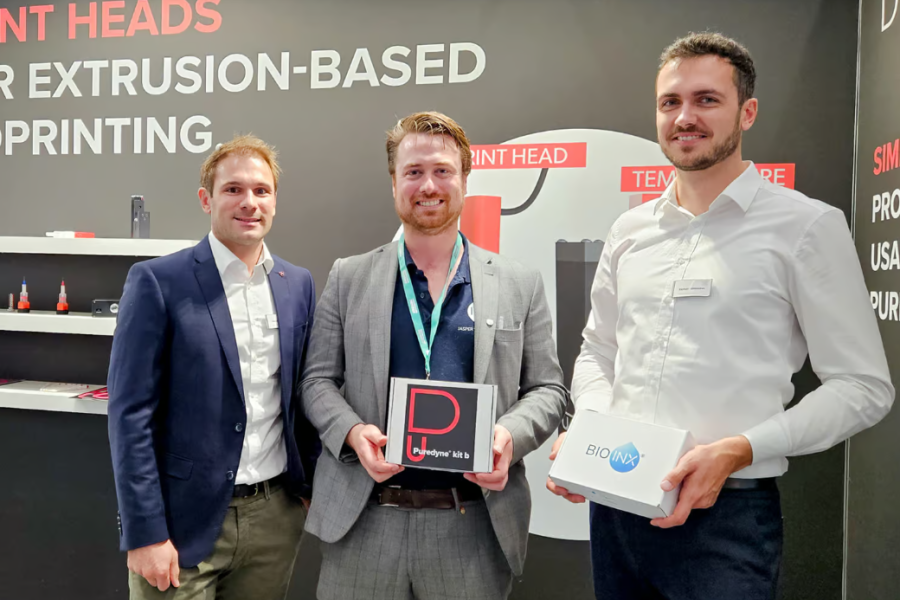BIO INX and Puredyne drive bioprinting application to the next level
From left to right: Felix Gruber (Puredyne), Jasper Van Hoorick (BIO INX) and Raphael Lichtnecker (Puredyne)
BIO INX and Puredyne are currently working together on a project to give even greater priority to combining the optimum biomaterial with precise printing technology. Gentle material handling and precise dispensing is the key for gaining the best results. At this year's Termis conference in Manchester, the Puredyne team met the Belgian biomaterial manufacturer in person for the first time.
"We believe that both BIO INX and Puredyne have a shared mission. At BIO INX we strive to make all our materials ‘plug & print’, meaning that there is limited optimization needed from our customers with maximized reproducibility. There are two roads towards that: optimal materials, but also optimized equipment. With the combination of the finetuned BIO INX materials with the optimized dispensing of the Puredyne printhead, turnkey bioprinting is closer than ever.” Jasper Van Hoorick, CEO at BIO INX
Joint trials are already promising. From synthetic to natural biomaterials for extrusion-based processes, the Puredyne printhead and BIO INX materials are a perfect match.
"The collaboration with BIO INX brings us forward in the field of regenerative medicine and highlights the advantages of Puredyne. Thanks to the precision control of the temperature control unit, the BIO INX materials can be optimally adjusted to the printing process - so we can guarantee a safe printing process." Felix Gruber, Business Development Manager at Puredyne.
Researchers can rely on the Puredyne printhead which doses the BIO INX biomaterial precisely, gently and therefore cost-effectively. At the same time, they retain flexibility in their choice of bioprinter. Further trials are already being planned in order to coordinate the material and print head even better.
Simply progressive. Simply usable. Simply pure.
Puredyne represents printheads that combine the proven ViscoTec dispensing technology with single-use cartridges. Thanks to the endless piston principle, Puredyne enables volumetric dispensing - regardless of viscosities and is particularly gentle. The new brand was created in 2021. The areas of application of the printheads include the fields of bioprinting and regenerative medicine, with plans to expand to other industries.
As the simplest, cleanest, and fastest solution for precise dispensing of viscous material in challenging bioprinting dispensing applications, the printheads are impressive - innovative and economical. The brand team maintains close contact with the market in order, on the one hand, to optimally serve the requirements of the application and, on the other hand, to recognize and react to new market trends at an early stage. Sustainable activities are closely anchored in the brand values.
Puredyne is a brand of ViscoTec Pumpen- u. Dosiertechnik GmbH. ViscoTec mainly deals with systems required for conveying, dosing, applying, filling and emptying medium to high-viscosity material. The headquarters of the technological market leader is located in Töging (Upper Bavaria, Altötting district, Germany). ViscoTec also has subsidiaries in the USA, China, Singapore, India, France and Hong Kong and employs around 330 people worldwide.
BIO INX
BIO INX is a spin-off from Ghent University and the Vrije Universiteit Brussel working on the development and commercialisation of materials for 3D bioprinting. It is currently one of the market leaders in terms of materials for high-resolution laser-based 3D bioprint technologies. Their mission is to develop innovative materials and solutions that allow researchers and clinicians to 3D-print advanced biomedical 'living' structures. To that end, BIO INX offers a whole portfolio of bio-inks for different bioprinting technologies, such as extrusion-based printing, digital light projection and 2-photon polymerisation. By offering a unique material portfolio with diverse material properties suitable for many cell types, the applications for 3D bioprinting become almost endless. These applications range from regenerative medicine to medicine development and reducing animal testing.

